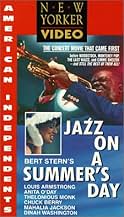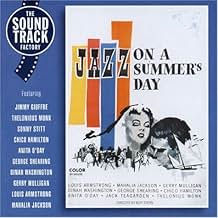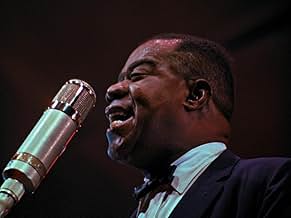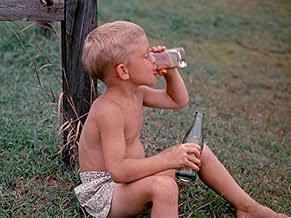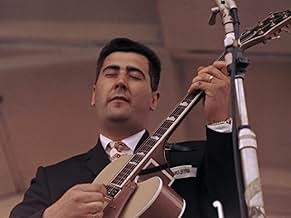VALUTAZIONE IMDb
7,9/10
2094
LA TUA VALUTAZIONE
Aggiungi una trama nella tua linguaThe highlights of the 1958 Newport Jazz Festival.The highlights of the 1958 Newport Jazz Festival.The highlights of the 1958 Newport Jazz Festival.
- Regia
- Sceneggiatura
- Star
- Premi
- 2 vittorie totali
Recensioni in evidenza
Not quite a concert film, not quite a travelogue, this "day and night in the life" of the Newport Jazz Festival is a delight. Some standout performances, including an unforgettable rendition of Sweet Georgia Brown by Anita O'Day and a gorgeous set by a beatific Mahalia Jackson would make this film worth watching all on their own. But, there's more. A very young Chuck Berry makes an appearance, and the earliest Rock and Roll seems boring by comparison to the many styles of jazz displayed in this film. Despite the repetitive groove, the folks in the audience can't help moving their feet to it and the future is foretold. Bert Stern deliberately moves the focus away from Berry's stage pyrotechnics and keeps it on the audience and the amused if bored jazz musicians. Did he know this was what the future held? Maybe. Bits and pieces of the lives of affluent Newport residents, a yacht race (America's Cup qualifying), jazz musicians practicing, a break into Bach by a cellist, dancing on the rooftops, all the small parts that make this film greater than their sum, this is one worth watching, and perhaps, like me, you'll find it one worth adding to your permanent library of musical film.
An exhilarating bullseye of music and spirit and a masterwork in aesthetics and observation.
Absolutely not a minute is wasted. Every decision of whether to show the performers, the audience, or the moments where it cuts to different scenes around the neighborhood (which could each function as a perfect short film on their own) all feels cohesively motivated in serving as a perfect testament to universal human joy and enthusiasm for creative spirits. The eye for capturing people in unguarded, emblematic moments serves as a fantastic precursor to Monterey Pop and Woodstock (as well as Neil Young's Weld but people aren't ready for that conversation yet) and its spirit was later taken to great effect by Jonathan Demme.
I get the sense that a great deal could be written about the larger cultural contexts that contributed to an object this pure and awesome being preserved, but for me its most inspiring as a testament to sensitive and committed people being on their absolute A-game for every aspect of production. This includes the people behind the camera having an acute sense for the perfect moments and angles to capture (and the showcase of lighting perfection from shot to shot, especially in such a free-form documentary setting, is absolute insanity), to the people responsible for the preservation of the film itself being so rich and beautiful, to the editors having an exacting sense of rhythm and kineticism (and making consistently creative and surprising choices among what must have been an intimidating amount of fantastic footage to curate), to the performers who each and every one of them manage at least one spellbinding and memorable moment (Anita O'Day being a total BEAST of a performer, Chuck Berry using a clarinet player to stunning effect, and Satchmo ascending to god form and winning music are just some of my favorites and I'm sure you'll have your own because every performance serves as a unique, full expression).
I cannot overstate what a revelation this film is, from the performances themselves to the cutaways to the life surrounding the festival, these are transcendent moments that form this fusion of music and image that feel like all of human existence was made in order to converge to this place and time, which is now available immaculately forever.
Absolutely not a minute is wasted. Every decision of whether to show the performers, the audience, or the moments where it cuts to different scenes around the neighborhood (which could each function as a perfect short film on their own) all feels cohesively motivated in serving as a perfect testament to universal human joy and enthusiasm for creative spirits. The eye for capturing people in unguarded, emblematic moments serves as a fantastic precursor to Monterey Pop and Woodstock (as well as Neil Young's Weld but people aren't ready for that conversation yet) and its spirit was later taken to great effect by Jonathan Demme.
I get the sense that a great deal could be written about the larger cultural contexts that contributed to an object this pure and awesome being preserved, but for me its most inspiring as a testament to sensitive and committed people being on their absolute A-game for every aspect of production. This includes the people behind the camera having an acute sense for the perfect moments and angles to capture (and the showcase of lighting perfection from shot to shot, especially in such a free-form documentary setting, is absolute insanity), to the people responsible for the preservation of the film itself being so rich and beautiful, to the editors having an exacting sense of rhythm and kineticism (and making consistently creative and surprising choices among what must have been an intimidating amount of fantastic footage to curate), to the performers who each and every one of them manage at least one spellbinding and memorable moment (Anita O'Day being a total BEAST of a performer, Chuck Berry using a clarinet player to stunning effect, and Satchmo ascending to god form and winning music are just some of my favorites and I'm sure you'll have your own because every performance serves as a unique, full expression).
I cannot overstate what a revelation this film is, from the performances themselves to the cutaways to the life surrounding the festival, these are transcendent moments that form this fusion of music and image that feel like all of human existence was made in order to converge to this place and time, which is now available immaculately forever.
This is a wonderful document of the 1958 Newport Jazz Festival and archetype for the concert film, with captivating interludes of visual poetry. As close as one can get to traveling back through time, watching the audience is as much fun here as watching the performers. You can recognize this film as a source of inspiration, perhaps, for the pretensions behind projects like "The Last Waltz," and one certainly gets a sense, given the caliber of the performers gathered onto a single stage, of the magnitude of this event without it ever being forced. The intimacy remains intact. And in contrast with the somber beat of "The Last Waltz," the sun shines on everything here. A joy.
Partly a jazz concert and partly a time capsule to a long ago era, "Jazz On A Summer's Day" records highlights of the four-day, 1958 festival held in Newport, Rhode Island. The film gets off to a slow start, with interviews of arriving audience, shots of Newport, and cutaways to the America's Cup yacht race, taking place concurrently.
About nine minutes into the film, the real program begins. The brilliant Thelonious Monk plays "Blue Monk" on the keys. From here on, most of the audio and visuals focus on the festival itself, except for brief visual cuts to the sailing event and impromptu shots of people enjoying themselves in presumably nearby locales. Although the film title says "day", about two-thirds of the film is shot at night.
Different styles of jazz provide ample variety, and run the gamut from an apparently unrelated boarding house jam session to the rockin', soul-stirring gospel music of Mahalia Jackson, who forcefully belts out three numbers at the end. Louis Armstrong and rarely filmed trombone legend Jack Teagarden perform a casual, seemingly improv vocal of "Old Rocking Chair". Dinah Washington singing "All Of Me", and the unusual percussion sounds of the Chico Hamilton Quintet are also quite good. But my personal favorite was Chuck Berry and band with a slowed down, beat thumpin' rendition of "Sweet Little Sixteen".
My only serious complaint is the film's editing, which includes the sailing event and quite a few extraneous visuals, and a too-brief overall runtime. A three-hour total jazz event would have been ideal.
The overall mood of the concert is upbeat, almost carnivalesque. The camera jumps back and forth between on-stage performers and audience reaction. Everyone seems to be having a good time. Glad to see this film recognized by the National Film Registry, to preserve an account of a unique event, held at a crucial moment in American history.
About nine minutes into the film, the real program begins. The brilliant Thelonious Monk plays "Blue Monk" on the keys. From here on, most of the audio and visuals focus on the festival itself, except for brief visual cuts to the sailing event and impromptu shots of people enjoying themselves in presumably nearby locales. Although the film title says "day", about two-thirds of the film is shot at night.
Different styles of jazz provide ample variety, and run the gamut from an apparently unrelated boarding house jam session to the rockin', soul-stirring gospel music of Mahalia Jackson, who forcefully belts out three numbers at the end. Louis Armstrong and rarely filmed trombone legend Jack Teagarden perform a casual, seemingly improv vocal of "Old Rocking Chair". Dinah Washington singing "All Of Me", and the unusual percussion sounds of the Chico Hamilton Quintet are also quite good. But my personal favorite was Chuck Berry and band with a slowed down, beat thumpin' rendition of "Sweet Little Sixteen".
My only serious complaint is the film's editing, which includes the sailing event and quite a few extraneous visuals, and a too-brief overall runtime. A three-hour total jazz event would have been ideal.
The overall mood of the concert is upbeat, almost carnivalesque. The camera jumps back and forth between on-stage performers and audience reaction. Everyone seems to be having a good time. Glad to see this film recognized by the National Film Registry, to preserve an account of a unique event, held at a crucial moment in American history.
Bert Stern captures the Newport Jazz festival of 1958 in vivid color and with clarity. While jazz is the primary focus of the film, Stern does meander to the America's Cup race that was being contested off Newport at the time, along with some diversionary local flavor, which gives us a sense of what it was like to actually be there. Continuing along this vein, during the festival itself, Stern spends much of his camera time observing the audience caught unaware reacting to jazz on a summer day; after all, live music does not exist in a vacuum. It's this footage along with the incredible jazz music that makes this documentary really special. As a viewer we get to react to the music, and react to the audience reacting to the music. That girl with the seductively cute smile in the yellow dress, and that gruff man hiding behind the shades with the nervous twitch are people that we can connect to from our own personal experiences at open air summer concerts. The feeling of community one gets as the music breaks down the barriers and the sun begins to set. Stern allows his moving compositions to develop and flesh out the character of his subjects, giving us a nostalgic feeling for a time gone by that may have occurred long before we were even born. It does not matter because we are there! But this particular slice of time has special significance, because jazz would soon be replaced in popularity by Rock & Roll. We watch it happen before our eyes as a young Chuck Berry takes the stage. Backed by some excellent jazz musicians, all looking "amused" but not taking very seriously the music that would knock them off the charts for good within a couple of years. As Berry's classic Rock & Roll riffs project across the audience, young people spontaneously jump to their feet and start moving to the rhythm while their parents watch, perplexed.
Lo sapevi?
- QuizIn Hilton Als' 2008 New Yorker review of the documentary Anita O'Day: The Life of a Jazz Singer (2007), Als reports that Anita O'Day was high on heroin during her performance at the 1958 Newport Jazz Festival, and she was unaware that her performance was filmed until later. O'Day spoke frankly about her struggles with heroin addiction in her 1981 autobiography.
- Citazioni
Louis Armstrong: I was at a little Italian trumpet player's house, and his mother was a Countess, well they was makin' that spaghetti and we was wailin', you know. In this big ol' dinin' room they had this table and up in the ceilin' they had Mark Anthony and Cleo and all the cats that they painted. Lookin' down on you as if to say, "Man, you shore can eat!"
[laughs]
Louis Armstrong: Well, we have a lot of fun travelin', man.
I più visti
Accedi per valutare e creare un elenco di titoli salvati per ottenere consigli personalizzati
- How long is Jazz on a Summer's Day?Powered by Alexa
Dettagli
Botteghino
- Lordo in tutto il mondo
- 74.811 USD
Contribuisci a questa pagina
Suggerisci una modifica o aggiungi i contenuti mancanti

Divario superiore
By what name was Jazz in un giorno d'estate (1959) officially released in India in English?
Rispondi





